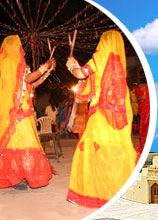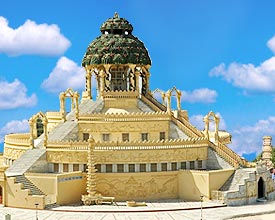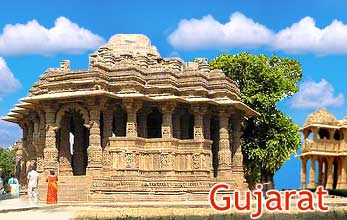 Patola
silk is often termed as the queen of all silks. Patola sarees of Gujarat
are one of the finest hand-woven sarees produced in India today. The
place associated with Patola is Patan. Here, exquisite patterns are
woven on sarees with great precision. Besides Patan, Surat is known for
patola patterns on velvets. Patola silk has an exciting history. It was
brought to Gujarat by the Salvi community of silk weavers from
Maharashtra and Karnataka. It is said that these weavers arrived in
Patan in the 12th century to make the most of the patronage of the
Solanki Rajputs.
Patola
silk is often termed as the queen of all silks. Patola sarees of Gujarat
are one of the finest hand-woven sarees produced in India today. The
place associated with Patola is Patan. Here, exquisite patterns are
woven on sarees with great precision. Besides Patan, Surat is known for
patola patterns on velvets. Patola silk has an exciting history. It was
brought to Gujarat by the Salvi community of silk weavers from
Maharashtra and Karnataka. It is said that these weavers arrived in
Patan in the 12th century to make the most of the patronage of the
Solanki Rajputs. After the downfall of the Solanki dynasty, the Salvis were patronized by an affluent Gujarati merchant. Soon, the patola sarees became a status symbol with Gujarati girls and women. It became an integral part of the wedding ceremonies in the region. The art of weaving Patola sarees is the most complex and meticulous job in this world. The exquisite textiles designs of the fabric are unique and simply amazing. In Patan, the Patola is done in ikkat style. This is a tedious process, which takes days of hard work.
Each Patola fabric is lined with a number of twisted threads. There is also a single weft thread, which binds the twisted threads together. Each twisted thread is tied and dyed according to the pattern of the saree. It is done in a manner so that the knotted portions of the thread do not catch color. This adds to the vibrance of the colors of the fabric. Apart from this, this makes the sarees look alike from both the sides and can be worn either ways. This is a unique feature of the Patola sarees. The weaving of these exclusive pieces is done in the traditional handlooms.
The colors used in this process are dyes made from vegetable extracts and other natural colors. These colors are so fast that there is a popular Gujarati saying about the Patola sarees that "the Patola may tear, but the color will not fade". The average time taken in creating a Patola marvel is usually 4 to 6 months, depending on the complexity of the pattern and design. These affluent sarees are thus, priced accordingly. The specialty of Patan patola is fine intricate patterns and typical geometric designs, with soft hazy outlines. This is the natural effect produced by the technique.
You can watch the complex weaving of patola in an area called Sadvi Wada, where it was once done for the queen and the nobles. Originally, patola was woven in four distinct styles by the Salvi community. For Jains and Hindus, it was done in double ikkat style with all over patterns of flowers, parrots, dancing figures and elephants. For the Muslim Vora community, wedding sarees were woven with geometric and floral designs. For Maharashtrian Brahmins, Nari Kunj sarees of plain, dark-color body and borders, with women and birds, were woven. Lastly, there were exclusive sarees woven for the traditional export markets in the Far East.









